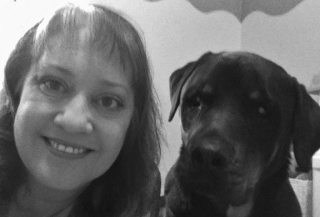Casual Dog Training

I am not a clicker trainer, nor do I always use a verbal behavior marker. Most of the time, when a dog does what I’d like the dog to do, I simply give the dog a reward. It may be a treat, a toy or access to something the dog wants like going outside or getting a good tummy rub.
I rarely set up formal training sessions with dogs. Since I’m teaching every day manners to dogs, I prefer on the job training. When dogs are present, regardless of what I’m doing, I’m also aware of what they are doing. I generally have three choices in response to their behavior at the moment.
Reward it
Ignore it
Interrupt/Manage it
If I’m answering emails and a puppy jumps up at me for attention, I simply ignore it. When the behavior changes to ignoring me and finding something else to do, I reward the dog with a “good girl!” If the puppy chooses to put all four paws on the floor and/or sits, I may reward it by tossing a toy or giving it a treat. If the puppy continues to jump on me, I will interrupt the behavior and manage the over-exuberance by redirecting the puppy to a chew toy or crating the puppy with a chewy until I’m finished with email.
If you’re a parent, this may sound very familiar. Rarely does the parent of a toddler set up toddler training sessions. Instead, they train the child through the simple process of responding to behavior as it happens. That’s how we live our lives with children, spouses, co-workers and even strangers. How we choose to respond to behavior will shape future behavior.
While this sounds very casual and perhaps thoughtless, it really shouldn’t be. I have thought out ahead of time how I will respond to various behavior. I have also set up the environment to facilitate success. By baby gating areas where I don’t want the puppy to be, having plenty of toys for the pup to play with, having a crate nearby and ready, and knowing what my choices of response are, I am not left to respond with knee-jerk reactions and emotion.
So, when my shepherd mix nudges my hand while I’m reading a book, I don’t mindlessly reward her attention seeking behavior by petting her. I’ve thought about this and planned my response, which is to ignore her and shift my position so that she can’t nudge my hand again. I’ve also planned how I will respond to the next thing she might do. If she chooses to sit and look at me, I may put my book down and pet her, or I may give her a chewy to keep her occupied until I’m finished reading. I may even choose to continue to ignore her so she gets bored with her attempts and simply finds something else to do.
This kind of training does take into account my beliefs about how dogs should be treated. In the scenario above, my shepherd mix is still being rewarded for initially seeking attention in several of the options, and I’m okay with that. I want my dog to communicate her needs, and needing attention is something we all experience. Over time, in my experience, she will learn that when I’m reading a book, I’m most likely going to direct her to a chew toy. Eventually, if she needs attention when I’m reading, she will simply go play with a toy and skip the middle man (me).




